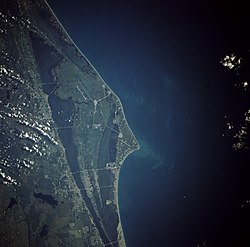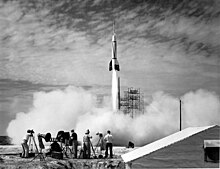Cape Canaveral Space Force Station
 Cape Canaveral from space | |
| Location | Cape Canaveral, Florida, USA |
|---|---|
| Area | 1,325 acres (5 km2)[1] |
| Built | 1950+[2] |
| NRHP reference No. | 84003872[1] |
| Significant dates | |
| Added to NRHP | April 16, 1984 |
| Designated NHLD | April 16, 1984[3] |

The Cape Canaveral Air Force Station (CCAFS) is an installation of the Air Force Space Command's 45th Space Wing (45 SW),[4] headquartered at nearby Patrick Air Force Base. Located on Cape Canaveral in the State of Florida, CCAFS is the primary Launch Head of the Eastern Range.[5] Patrick AFB provides headquarters and support functions for the 45 SW, as well as a major airfield complex, logistical air head and the full-service support functions of a typical air force base. In addition to the facilities at Patrick AFB, CCAFS also has its own separate airfield, the Cape Canaveral AFS Skid Strip, which provides a 10,000 foot runway[6] closer to the launch complexes for military airlift aircraft delivering heavy and outsized satellite payloads to the Cape.
CCAFS is also located adjacent to the NASA John F. Kennedy Space Center on Merritt Island, with the two facilities linked by bridges and causeways.
History
The CCAFS area had been used by the United States government since 1949 when President Harry S. Truman established the Joint Long Range Proving Grounds at Cape Canaveral to test missiles. The location was among the best in the continental United States for this purpose as it allowed for launches out toward the Atlantic Ocean, and it was closer to the equator than most other parts of the United States, allowing rockets to get a boost from the Earth's rotation.

On 1 June 1948, the U.S. Navy transferred the former Naval Air Station Banana River to the U.S. Air Force, with USAF renaming the facility the Joint Long Range Proving Ground (JLRPG) Base on 10 June 1949. On 1 October 1949, the Joint Long Range Proving Ground Base was transferred from the Air Materiel Command to the Air Force Division of the Joint Long Range Proving Ground. On 17 May 1950, the base was renamed the Long Range Proving Ground Base, but three months later was renamed Patrick Air Force Base, in honor of Major General Mason Patrick.[7] In 1951, the Air Force established the Air Force Missile Test Center.
Early American sub-orbital rocket flights were achieved at Cape Canaveral in 1956.[8] These flights were shortly after some sub-orbital flights at White Sands, like Viking 11 on May 24, 1954. [9] Following the Soviet Union's successful Sputnik 1, the US attempted its first launch of an artificial satellite from Cape Canaveral on December 6, 1957. However, the rocket carrying Vanguard TV3 blew up on the launch pad. NASA was founded in 1958 and Air Force crews launched missiles for NASA from CCAFS. Redstone, Jupiter, Pershing, Polaris, Thor, Atlas, Titan and Minuteman missiles were all tested from the site, the Thor becoming the basis for the expendable launch vehicle (ELV) Delta rocket, which launched Telstar 1 in July 1962. The row of Titan (LC-15, 16, 19, 20) and Atlas (LC-11, 12, 13, 14) launch pads along the coast came to be known as Missile Row in the 1960s. NASA's early manned spaceflights, Mercury and Gemini, were prepared for launch from Cape Canaveral Air Force Station launch pads LC-5, LC-14 and LC-19 by U.S. Air Force crews.
The Air Force chose to expand the capabilities of the Titan launch vehicles for its heavy lift capabilities. The Air Force constructed Launch Complexes 40 and 41 to launch Titan III and Titan IV rockets just south of Kennedy Space Center. A Titan III has about the same payload capacity as the Saturn IB at a considerable cost savings. Launch Complex 40 and 41 have been used to launch defense reconnaissance, communications and weather satellites and NASA planetary missions. The Air Force also planned to launch two Air Force manned space projects from LC 40 and 41. They were the Dyna-Soar, a manned orbital rocket plane (cancelled in 1963) and the USAF Manned Orbital Laboratory (MOL), a manned reconnaissance space station (cancelled in 1969).
From 1974-1977 the powerful Titan-Centaur became the new heavy lift vehicle for NASA, launching the Viking and Voyager series of spacecraft from Launch Complex 41. Complex 41 later became the launch site for the most powerful unmanned U.S. rocket, the Titan IV, developed by the Air Force.
Current use and limitations
Launch Complexes
Of the 47[citation needed] Launch Complexes built since 1950, only four remain active with two planned for future use. Launch Complex SLC-17 is the home of the Delta II.[10] Launch Complexes SLC-37 and SLC-41 have now been modified to launch EELV Delta IV and Atlas V launch vehicles, respectively.[11] These new launch vehicles will replace all earlier Delta, Atlas, and Titan rockets. Launch Complex SLC-47 is used to launch weather sounding rockets. Launch Complex SLC-46 is reserved for future use by the Spaceport Florida Authority.[12] Launch Complex SLC-40 is expected to host the first launch of the SpaceX Falcon 9 in the fourth quarter of 2009.[13]
In the case of low-inclination (geostationary) launches the location of the area at 28°27′N put it at a slight disadvantage against other launch facilities situated nearer the equator. The boost eastward from the earth's rotation is about 405 m/s (about 900 miles per hour) at Cape Canaveral against about 465 m/s (1,035 miles per hour) at the European Guiana Space Centre in French Guiana.[14]
In the case of high-inclination (polar) launches the latitude does not matter, but the Cape Canaveral area is not suitable because inhabited areas underlie these trajectories; Vandenberg Air Force Base, Cape Canaveral's West coast counterpart, is used instead.
-
Map of launch complexes.
-
Launch pad 39A and neighboring pad 39B.
Museum
Cape Canaveral Air Force Station also contains the Air Force Space & Missile Museum.[15]
See also
References
- ^ a b "National Register of Historical Places — Florida (FL), Brevard County". National Register of Historic Places. National Park Service. 2007-09-23.
- ^ "Cape Canaveral Air Force Station". Florida Heritage Tourism Interactive Catalog. Florida's Office of Cultural and Historical Programs. 2007-09-23.
- ^ Cape Canaveral Air Force Station at National Historic Landmarks Program.
- ^ a b "Patrick Air Force Base — FAQ Topic". Patrick Air Force Base.
- ^ CAST 1999, p. 1-12.
- ^ "World Aero Data: Cape Cnaveral AFS Skid Strip — XMR". Retrieved 2008-08-31.
- ^ CAST 1999, p. 1-5.
- ^ Cape Canaveral LC5
- ^ Encyclopedia Astronautica
- ^ CAST 1999, p. 1-26.
- ^ CAST 1999, p. 1-31.
- ^ CAST 1999, p. 1-35.
- ^ SpaceX Corp (2009-10-23). "Dragon/ Falcon 9 Update". SpaceX. Retrieved 2009-11-10.
- ^ ASP: Up, Up, and Away
- ^ CAST 1999, pp. 1-29 to 1-30.
- Research Triangle Institute Center for Aerospace Technology (CAST) Florida Office (1999). "LAUNCH SITE SAFETY ASSESSMENT, SECTION 1.0 EASTERN RANGE GENERAL RANGE CAPABILITIES" (PDF). Federal Aviation Administration. Retrieved 2008-08-31.
{{cite web}}: Unknown parameter|month=ignored (help)





